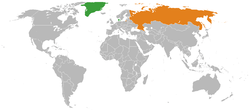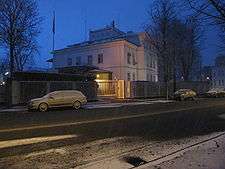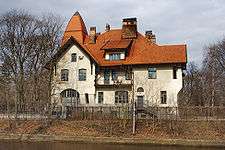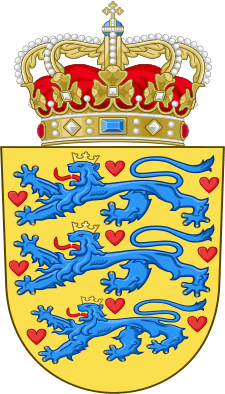Denmark–Russia relations
 |
|
Denmark |
Russia |
|---|---|


Denmark–Russia relations is the relationship between the two countries, Denmark and Russia. Diplomatic relations between Denmark and the USSR were established on June 18, 1924. Russia has an embassy in Copenhagen and a consulate in Tórshavn, and Denmark has an embassy in Moscow, a Consulate-General in Saint Petersburg, and an honorary consulate in Kaliningrad. Both countries border the Baltic Sea and are members of the Council of Europe and the Organization for Security and Co-operation in Europe.
History
Early Modern era
Amicable relations between the Kingdom of Denmark and the Muscovite state were based on a mutual assistance pact of 1493, renewed in 1506 and 1517.[1] In 1562, the Danish king Frederick II and the Russian tsar Ivan IV continued amicable relations based on the Treaty of Mozhaysk.[2]
18th century
Great Northern War
During the Great Northern War, a coalition of various states successfully attacked the Swedish Empire in northern Central and Eastern Europe. Initially, the anti-Swedish alliance was composed of the Tsardom of Russia, Denmark-Norway, and Saxe-Poland-Lithuania. Frederik IV and August the Strong were forced out of the alliance in 1700 and 1706, respectively, but re-joined it in 1709. George I of Brunswick-Lüneburg (Hanover) joined the coalition in 1714 for Hanover, and 1717 for Britain, and Frederick William I of Brandenburg-Prussia in 1715. On the Swedish side were Holstein-Gottorp (a Danish vassal), between 1704 and 1710 several Polish and Lithuanian magnates under Stanisław Leszczyński, and between 1708 and 1710 cossacks under Ivan Mazepa. The Ottoman Empire temporarily hosted Charles XII of Sweden and intervened against Peter the Great.
After fighting in various other theatres went against the Swedes, Sweden proper was invaded by Denmark-Norway from the west and by Russia from the east. Though the Danish attacks were repulsed, Russia managed to occupy Finland and inflict severe losses on the Swedish navy and coastal fortresses. Charles XII opened up a Norwegian front, but was killed in Fredriksten in 1718. The war ended with a defeat for Sweden, leaving Russia as the new major power in the Baltic Sea and a new important player in European politics — in fact, it signed the beginning of a pattern of Russian expansion that would only be stopped two centuries later. Denmark gained little from Sweden in the peace settlement, but it was able to gain at the expense of its disloyal vassal in Holstein.
Holstein-Gottorp
Sweden's defeat in the Great Northern War ended its patronage for Holstein-Gottorp, and Denmark used the occasion to seize Gottorp's territory in Schleswig.[3] The frustrated Duke of Holstein-Gottorp sought support for the recovery of Schleswig in Russia and married into the Russian imperial family in 1725. Russian Empress Elizabeth died childless in 1762, and she appointed her nephew, the Duke of Holstein-Gottorp, to be her successor in Russia. When he ascended the throne as Tsar Peter III of Russia, Holstein-Gottorp came to be ruled in personal union by the Emperor of Russia, creating a conflict of territorial claims between Russia and Denmark.[4]
Peter III threatened war with Denmark for the recovery of his ancestral lands, but before any fighting could begin he was overthrown by his wife, who took control of Russia as Tsarina Catherine II.[5] Empress Catherine reversed Russia's stance, withdrawing her husband's ultimatum and even entering an alliance with Denmark in 1765. In the 1760s the two governments negotiated the transfer of ducal Schleswig-Holstein to the Danish crown in return for Russian control of the County of Oldenburg and adjacent lands within the Holy Roman Empire, an exchange that was formalized with the 1773 Treaty of Tsarskoye Selo. The alliance that accompanied the territorial exchange tied Denmark's foreign policy to Russia's and led directly to Denmark's involvement in a series of wars over the succeeding decades.
Russo-Swedish War (1788–1790)
When Sweden attacked Russia in 1788, Denmark upheld its treaty obligations to Russia and declared war on Sweden. A Norwegian army briefly invaded Sweden and won the Battle of Kvistrum Bridge, before peace was signed on July 9, 1789 following the diplomatic intervention of Great Britain and Prussia. Under their pressure, Denmark-Norway declared itself neutral in the Russo-Swedish conflict, bringing this war to an end.
19th century
French Revolutionary and Napoleonic Wars
During the French Revolutionary Wars, Denmark and Russia were allies in the Second League of Armed Neutrality in resisting the British Royal Navy's wartime policy of searching neutral shipping for French contraband, which led to the British Navy's attack on Denmark at the 1801 Battle of Copenhagen. During the subsequent Napoleonic Wars Russia and Denmark were members of Napoleon's Continental System, which led the British to launch another naval attack on Copenhagen in 1807. This bombardment began the Anglo-Russian War (1807–12) and drew Denmark into the Napoleonic conflicts in the Dano-Swedish War of 1808–09, in which both Russia and Denmark fought on France's side.
However, Napoleon's disastrous 1812 invasion of Russia pushed Russia to the opposing, British-led side in the War of the Sixth Coalition, while Denmark remained a French client. When France was eventually defeated by the Sixth Coalition, Denmark was forced to cede control of Norway to Sweden in the 1814 Treaty of Kiel, accelerating Denmark's decline as a major power in Europe.
Schleswig Wars
As German nationalism rose in the mid-1800s, the Schleswig-Holstein Question came to dominate Denmark's foreign affairs. After the First Schleswig War Russia took Denmark's side in the negotiation of the 1852 London Protocol, which reaffirmed Danish sovereignty in the disputed duchies. Russia also offered diplomatic support for Denmark in the Second Schleswig War but did not make a military intervention, and Denmark ultimately lost Schleswig-Holstein in its entirety to Prussia in the 1864 Treaty of Vienna.
Empress Maria Feodorovna
In 1866 Danish Princess Dagmar, a daughter of King Frederick VIII, married the future Tsar Alexander III of Russia, taking the Russian name Maria Feodorovna. She was a popular empress and became the mother of Russia's last Tsar, Nicholas II. As Russian Empress, she donated funds for the construction of a Russian Orthodox Church in Copenhagen as a gift to the Orthodox community in Denmark. In September 2006 her remains were transferred from Denmark to St. Petersburg to be interred beside her husband.
20th century
Soviet Union
After the 1917 Russian Revolution, Denmark recognized the Soviet Union and established diplomatic relations in 1924. Though the Danish government sought to remain neutral in both World Wars, the country was occupied by Nazi Germany in 1940 and joined the Anti-Comintern Pact in 1941 (though it insisted upon its neutrality in any conflict with Russia). Denmark also never recognized the Soviet Union's annexation of the Baltic Republics as legitimate. After World War II ended Denmark became a founding member of the North Atlantic Treaty Organisation (NATO) in 1949, though its foreign policy continued to incline more toward neutrality than confrontation with the Soviet Union.
Present
Today, both countries are close trading partners, and trade mainly along the Baltic coast. The Faroe Islands was the only Danish overseas territory that decided to negotiate a free trade agreement with Russia.[6] The trade will go through Denmark, and then to Russia. There are also some Russian fishermen visiting Tórshavn, the capital of the islands. On May 27, Russia and Denmark signed visa agreements. Per Stig Møller, then Foreign Minister of Denmark, stated that the agreements will help to ease contacts between scientists, businessmen and students of the two countries. The deal was also an inline agreement between Russia and the European Union.
In August 2014, the Danish government announced that it would contribute to NATO's missile defense shield by equipping one or more of its frigates with radar capacity, amid the Ukrainian crisis and growing tensions between Russia and NATO.[7] On March 22, 2015, tensions grew between the two countries when Russia's ambassador to Denmark, Mikhail Vanin, said during an interview to Jyllands-Posten: "I do not think Danes fully understand the consequences of what happens if Denmark joins the US-led missile defense. If this happens, Danish warships become targets for Russian nuclear missiles". Denmark's foreign minister, Martin Lidegaard, said that the ambassador's remarks were unacceptable and that the defense system was not aimed at Russia, a claim echoed by NATO's spokeswoman, Oana Lungescu, who added that the statements "do not inspire confidence or contribute to predictability, peace or stability".[8][9]
See also
- Foreign relations of Denmark
- Foreign relations of Russia
- Embassy of Russia in Copenhagen
- Embassy of Denmark in Moscow
- Consulate-General of Denmark in Saint Petersburg
- Russian ambassadors to Denmark
References
- ↑ Hübner, Eckhard (1998). "Zwischen alle Fronten: Magnus von Holstein als König von Livland". In Hübner, Eckhard; Klug, Ekkehard; Kusber, Jan. Zwischen Christianisierung und Europäisierung. Beiträge zur Geschichte Osteuropas in Mittelalter und früher Neuzeit. Festschrift für Peter Nitsche zum 65. Geburtstag. Quellen und Studien zur Geschichte des östlichen Europa (in German). 51. Stuttgart: Steiner. pp. 313–334 [317]. ISBN 3-515-07266-7.
- ↑ Hübner, Eckhard (1998). "Zwischen alle Fronten: Magnus von Holstein als König von Livland". In Hübner, Eckhard; Klug, Ekkehard; Kusber, Jan. Zwischen Christianisierung und Europäisierung. Beiträge zur Geschichte Osteuropas in Mittelalter und früher Neuzeit. Festschrift für Peter Nitsche zum 65. Geburtstag. Quellen und Studien zur Geschichte des östlichen Europa (in German). 51. Stuttgart: Steiner. pp. 317–318. ISBN 3-515-07266-7.
- ↑ Frost, Robert I. (2000). The Northern Wars: War, State and Society in Northeastern Europe 1558–1721. Longman. ISBN 978-0-582-06429-4.
- ↑ Ragsdale, Hugh; Ponomarev, V. N. (1993). Imperial Russian Foreign Policy. Cambridge University Press. pp. 56–58. ISBN 9780521442299. Retrieved 3 November 2016.
- ↑ Tytler Woodhouselee, Lord Alexander Fraser (1823). Elements of General History, Ancient and Modern. H. Hill. pp. 428–429. Retrieved 4 November 2016.
- ↑ Faroe Islands negotiate free trade agreement with Russia
- ↑ Cullinane, Susannah (23 March 2015). "Denmark slams Russian envoy's nuclear target warning". CNN. Retrieved 24 March 2015.
- ↑ "Russia threatens to aim nuclear missiles at Denmark ships if it joins NATO shield". Reuters. 22 March 2015. Retrieved 24 March 2015.
- ↑ Khan, Maria (22 March 2015). "Russia threatens Denmark with naval nuclear attack". International Business Times. Retrieved 24 March 2015.
External links
- Danish embassy in Moscow
- Russian embassy in Copenhagen
- Russia, Denmark sign visa facilitation, readmission agreements

